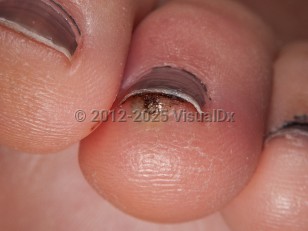Tungiasis
Alerts and Notices
Important News & Links
Synopsis

Tungiasis is a cutaneous parasitic infestation, typically limited to the feet, that occurs after a flea burrows into the skin. Most commonly, the female sand flea Tunga penetrans causes infection; however, the Tunga trimamillata flea can result in disease as well. The infestation is also known as chique, chica, nigua, sand flea, bicho do pé, and puce chique.
Tungiasis is endemic in sub-Saharan Africa, India, the Caribbean, and Central and South America. It is usually acquired while walking barefoot on sand or in shady areas near rotting vegetation. Children are at higher risk (peak age of incidence is 5-10 years), and boys are at slightly higher risk than girls. Risk factors include not wearing closed-toe footwear, poverty, and proximity to domestic or wild animal reservoirs (as fleas may exist on these animals).
Because the flea cannot jump very high, involved sites are usually limited to the feet, especially periungually. However, in small children, ectopic sites above the waist are not uncommon.
Tungiasis initially presents as red or brown macules that become nontender papules around the toenails within 24 hours of exposure. Each papule contains a flea. Within a week, the flea matures and swells to a diameter of 1 cm and may harbor up to 200 ova. The site becomes painful after 2-3 days as this engorgement occurs.
If left untreated, the site becomes very pruritic, causing the host to scratch at the lesions, which results in rupture of the flea and dissemination of eggs. The lesions then become desiccated and may leave small scars.
Tungiasis is endemic in sub-Saharan Africa, India, the Caribbean, and Central and South America. It is usually acquired while walking barefoot on sand or in shady areas near rotting vegetation. Children are at higher risk (peak age of incidence is 5-10 years), and boys are at slightly higher risk than girls. Risk factors include not wearing closed-toe footwear, poverty, and proximity to domestic or wild animal reservoirs (as fleas may exist on these animals).
Because the flea cannot jump very high, involved sites are usually limited to the feet, especially periungually. However, in small children, ectopic sites above the waist are not uncommon.
Tungiasis initially presents as red or brown macules that become nontender papules around the toenails within 24 hours of exposure. Each papule contains a flea. Within a week, the flea matures and swells to a diameter of 1 cm and may harbor up to 200 ova. The site becomes painful after 2-3 days as this engorgement occurs.
If left untreated, the site becomes very pruritic, causing the host to scratch at the lesions, which results in rupture of the flea and dissemination of eggs. The lesions then become desiccated and may leave small scars.
Codes
ICD10CM:
B88.1 – Tungiasis [sandflea infestation]
SNOMEDCT:
64612002 – Tunga penetrans infestation
B88.1 – Tungiasis [sandflea infestation]
SNOMEDCT:
64612002 – Tunga penetrans infestation
Look For
Subscription Required
Diagnostic Pearls
Subscription Required
Differential Diagnosis & Pitfalls

To perform a comparison, select diagnoses from the classic differential
Subscription Required
Best Tests
Subscription Required
Management Pearls
Subscription Required
Therapy
Subscription Required
References
Subscription Required
Last Reviewed:10/15/2020
Last Updated:10/15/2020
Last Updated:10/15/2020
Tungiasis

